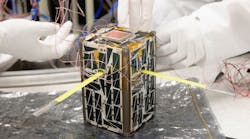Both commercial satellite companies and government agencies are sending out smaller satellites, probes, and capsules into orbit that perform a narrow range of tasks and are cheaper to build.
In the next 20 years, the majority of satellites scheduled for launch will be extremely small and placed in low-earth orbits, according to a report from aerospace research firm Teal Group. The report found that 5,095 payloads were scheduled to be built and launched between 2016 and 2035.
“It’s going to get extremely crowded at low earth orbits,” says Marco Caceres, senior space analyst at the Teal Group and author of the report. Companies will launch "potentially thousands of small low earth orbit broadband satellites aimed at expanding Internet connectivity worldwide,” he said.
For instance, Iridium Communications—which operates a constellation of 66 satellites in low earth orbit—is planning to launch new satellites to provide faster data coverage to satellite phones and integrated transceivers. The first 10 satellites in the Iridium Next constellation are scheduled for flights with SpaceX in late 2016.
More than four out of every five payloads will be positioned in low-earth orbits, carrying out tasks from communications to meteorological, imaging, and location services. The report also says that around three-fifths of the payloads will be commercial equipment, while one-fifth will be government spacecraft. Only about one-tenth will be used by military programs.
Government agencies are also sending out small, low-cost satellites to perform a narrow range of simple research tasks. Next year, NASA plans to send eight microsatellites in low-earth orbit to monitor tropical storms, hurricanes, and typhoons throughout their lifecycle. Every year, the agency also sends out several tiny research satellites, or Cubesats, as auxiliary payloads on rockets carrying heavier cargo.
The smaller sizes and lower costs are evidently making it easier to send satellites into orbit. The payload count for 2016 to 2035 reflects a 10% increase compared to the 4,607 payloads identified in 2015. It is also 36% and 38% higher than reports in 2013 and 2014, respectively. And yet the payloads built and launched over the next 20 years will total more than $245 billion.
About one-fifth of the satellites identified in the report are expected to be sent into deeper orbits. The next generation of GPS satellites could be launched into medium earth orbits starting around 2017. Inmarsat, a satellite communications company, is planning to send new satellites into geostationary orbit to provide faster and more reliable television and mobile service.
Looking for parts? Go to SourceESB.
